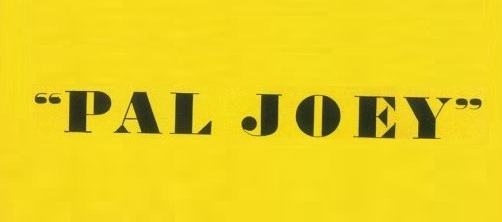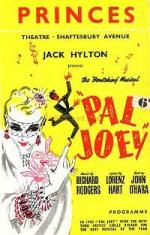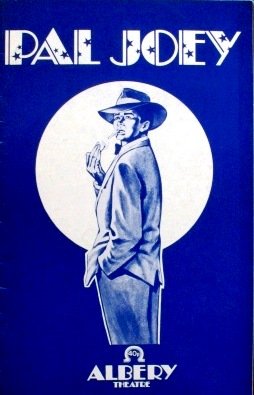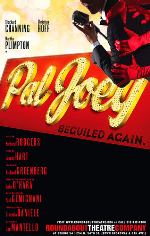
Pal Joey () est une rupture profonde avec ce Rodgers et Hart ont fait jusque là. La manière dont ils abordent la personnalité des personnages peut faire penser à ce que Sondheim fera 30 ans plus tard, par exemple dans Company ().
Le livret est inspiré d'une série d'histoires que John O'Hara avait écrites pour The New Yorker, sur un chanteur/animateur de boîte de nuit miteux (Gene Kelly) et les femmes qu'il séduit et abuse. Ce n'était pas une jolie histoire, et certains critiques, y compris le plus important, Brooks Atkinson du New York Times, ont constaté que les vertus évidentes du spectacle étaient minées par son histoire sordide: «Bien que Pal Joey a été conçu de manière experte, pouvez-vous puiser de l'eau douce dans un puit insalubre?»
Le malsain chanteur/danseur de boîte de nuit Joey courtise une jeune femme naïve dans la vingtaine d’années tout en couchant avec Vera, la femme fatiguée d’un millionnaire — qui lui offrira sa propre boîte de nuit. À la fin du spectacle, les deux femmes larguent Joey, qui partira sans rien avoir appris de cette histoire…
Acte I
In Chicago in the late 1930s, singer/dancer Joey Evans, a charming "heel" with big plans, schemes to get his own nightclub. He auditions for an emcee job at a second-rate nightclub (You Mustn't Kick It Around). Joey gets the job and begins rehearsals with the chorus girls and club singer Gladys Bumps. Joey meets young and naïve Linda English outside a pet shop, and he impresses her with grandiose lies about his career. Linda innocently falls for Joey's line (I Could Write a Book). As the chorus girls are doing a song-and-dance number at the club that night (Chicago), Linda arrives with a date. Wealthy married socialite Vera Simpson arrives at the club and shows a definite interest in Joey. Joey plays hard-to-get and insults Vera, who walks out. Mike, the club owner, fires Joey, but Joey, believing Vera will be back, strikes a deal: if Vera doesn't come back within the next few days, Joey will leave without pay. The chorus girls continue with the show (That Terrific Rainbow); Linda, having witnessed Joey's caddish behavior, has left the club. Vera doesn't return, so Joey is fired. When Linda refuses to answer his calls, Joey calls Vera (What is a Man). After Joey's last night as emcee, Vera picks him up from the club and they start an affair (Happy Hunting Horn). Vera is glowing in the romance and sets Joey up with an apartment and expensive clothes (Bewitched, Bothered and Bewildered). While shopping for clothes for Joey, he and Vera run into Linda, leaving Vera jealous and Linda distraught. Vera gives Joey his own nightclub, "Chez Joey", and Joey looks forward to rising to the top (Pal Joey/Joey Looks to the Future ballet).
Acte II
The chorus girls and singers from the old club have relocated to "Chez Joey", where they rehearse for the opening performance (The Flower Garden of My Heart). Melba, an ambitious reporter, interviews Joey, recalling her interviews with various celebrities, including Gypsy Rose Lee (Zip), especially notable given original star June Havoc was Lee's sister [In the 2008 revival, Gladys plays a "reporter" in a skit during the floor show at Chez Joey, performing "Zip" as a striptease]. Ludlow Lowell, Gladys' old flame, introduces himself as an agent with papers that Joey unthinkingly signs as the rehearsal continues (Plant You Now, Dig You Later). In Joey's apartment the next morning, Joey and Vera reflect on the pleasures of their affair (In Our Little Den). Linda overhears Gladys and Lowell plotting to use the papers Joey signed to blackmail Vera. [In the 2008 revival, Joey fires Gladys, and to get back at him, she conspires with Mike, the club manager, to blackmail Vera. Mike is forced into the scheme because Gladys threatens to have him fired because he is gay.] Linda calls Vera, who initially distrusts Linda; Vera confronts Joey, asking what his relationship is with Linda, and Joey responds defensively (Do It the Hard Way). Linda comes to the apartment to convince Vera, and Vera, seeing Linda's sincerity, now believes her. Vera and Linda agree that Joey is not worth the trouble (Take Him). Vera calls her friend the police commissioner, who arrests Gladys and Lowell. Vera throws Joey out and closes "Chez Joey" (Bewitched, Bothered, and Bewildered/span> reprise). Joey, now penniless, runs into Linda again outside the pet shop, and she invites him to dinner with her family. He joins for a meal and then they part as friends, with him claiming to have been cast in a nonexistent show in New York. In the 1952 revival, he was shown to have a change of heart, turning just before the curtain falls to follow her.
Une des légendes durables du théâtre musical est que la production originale de Pal Joey fut un échec que personne n’apprécia jusqu’au revival de Broadway en 1952. Rien n’est plus faux. Lorsque le musical ferme à la création en 1941, il est celui qui a la deuxième plus longue série de tous les musicals de Rodgers et Hart, avec une série de 374 représentations. Jusque là, seul A Connecticut Yankee () en 1927 s'était joué plus longtemps, avec 418 représentations. En 1942, By Jupiter () s’imposera comme leur plus long spectacle avec un total de 427 représentations.
1 Pal Joey peut-être considéré comme un Top musical
1940 - Création à Broadway
Pal Joey a été créé à Broadway le 25 décembre 1940 au Ethel Barrymore Theatre où il s'est joué Durant 374 représentations. Mis en scène par George Abbott avec des chorégraphies de Robert Alton, le spectacle était interprété par Gene Kelly (Joey), Vivienne Segal (Vera) et June Havoc (Gladys). Même si le musical a désarçonné le grand public et une parite de la presse, ce fut un grand succès, deuxième plus longue série à l'époque du duo Rodgers & Hart.
1952 – Revival à Broadway
Le succès de Pal Joey a continué à croître avec les temps. Tout au long des années '40, les chansons de Pal Joey ont été interdites à la radio par l’ASCAP, les empêchant de devenir des standards populaires. Mais cette interdiction a été levée à la fin des années '40. En 1950, la chanson Bewitched, Bothered and Bewildered devient un véritable tube et est enregistrée par divers groupes et chanteurs pop, dont Mel Torme, Doris Day, Gordon Jenkins et The Harmonicats. Poussé par le succès de la chanson, Goddard Lieberson, le producteur de Columbia Records, décide de produire un album studio de Pal Joey avec Harold Lang dans le role de Joey et Vivienne Segal reprenant son rôle de Vera. En raison de la popularité de cet enregistrement, le compositeur-producteur Jule Styne a décidé de produire un revival en 1952, dans lequel Lang et Segal ont joué.
Le revival de 1952 connut un plus grand succès que la production originale. Il a ouvert le 3 janvier 1952 et a fermé le 18 avril 1953, après 540 représentations!!!. Harold Lang et Vivienne Segal ont joué les rôle principaux, accompagnés de Helen Gallagher dans le rôle de Gladys (pour laquelle Gallagher a remporté le Tony Award de la meilleure actrice), la future vedette de Broadway Elaine Stritch dans le rôle de Melba, Jack Waldron dans le rôle de Mike Spears, et Bob Fosse - le future célébrissime chorégraphe – comme understudy de Joey. Les chorégraphies sont à nouveau signées par Robert Alton et le spectacle est mis en scène par David Alexander. Cette production est devenue la plus longue série pour un revival de l’histoire du théâtre de Broadway à l’époque. Il a remporté le New York Drama Critics' Circle Award for Best Musical et est devenu le premier musical à recevoir onze Donaldson Awards.
Elaine Stritch a été engagée en tant qu'understudy d’Ethel Merman dans Call Me Madam ()à l’époque; elle décrit les difficultés de tenir les deux emplois après les avant-premières inopinément déplacées à New Haven dans un monologue encadré par "Zip" dans son one-woman show Elaine Stritch à Liberty.
1954 – Création à Londres
La creation à Londres a eu lieu en mars 1954 au Princes Theatre, avec Harold Lang, Carol Bruce et Sally Bazely.
1963 – City Center Revival
Montée au New York City Center, cette production a mis en vedette Bob Fosse dans le role de Joey Evans, Viveca Lindfors comme Vera Simpson, Rita Gardner comme Linda English, Elaine Dunn comme Gladys Bumps, Kay Medford comme Melba Snyder, et Jack Durant comme Ludlow Lowell. Alors qu’il ne s'est joué que pour 15 représentations du 29 mai 1963 au 09 juin 1963, Fosse est nominé pour un Tony Award pour sa performance. La production a été mise en scène par Gus Schirmer Jr., avec des décors de Howard Bay et des costumes de Frank Thompson.
1976 – Revival à Broadway
Un revival à Broadway a ouvert le 27 juin 1976, au Circle in the Square Theatre pour 73 représentations et a fermé le 29 août 1976. Le spectacle était mis en scène par Theodore Mann et chorégraphié par Margo Sappington.
Le cast comprenait Christopher Chadman (Joey), Harold Gary (Mike), Terri Treas (Kid), Janie Sell (Gladys), Gail Benedict (Gail), Murphy Cross (Murphy), Rosamond Lynn (Rosamond), Marilu Henner (Marilu), Deborah Geffner (Debbie), Boni Enton (Linda), David Hodo (Gent). Austin Colyer (Ernest), Denny Martin Flinn (Waldo the Waiter), Michael Leeds (Victor), Kenn Scalice (livreur), Adam Petroski (Louis), Joe Sirola (Ludlow Lowell), Ralph Farnworth (O’Brien), Dixie Carter (Melba) et Joan Copeland (Vera).
1980 – Revival à Londres
La seconde version à Londres eut lieu au Noël Coward Theatre, de septembre 1980 à septembre 1981, avec Siân Phillips, Danielle Carson et Denis Lawson.
2008 – Revival à Broadway
Le producteur Marc E. Platt, accompagné de Richard Greenberg et le metteur en scène Joe Mantello ont prévu un revival pour l’automne 2007, qui a été reportée.
La Roundabout Theatre Company et Marc E. Platt ont présenté une série limitée, avec des avant-premières commençant le 14 novembre 2008, ouvrant officiellement le 18 décembre 2008 et fermant le 1er mars 2009. Le livret original de John O’Hara avait subi une "adaptation" substantielle par Greenberg, éliminant des personnages et réattribuant des chansons. Cette nouvelle production comprenait également une chanson pour Joey qui avait été coupée avant la première de Broadway en 1940, I’m Talking to My Pal, et a également incorporé deux chansons de Rodgers & Hart, qui ont été chantées par Joey et Linda: Are You My Love? (provenant du film de 1936 Dancing Pirate) et I Still Believe in You (extrait du musical Simple Simon () de 1930).
Acte I
“You Mustn’t Kick It Around” (Gene Kelly, June Havoc, Diane Sinclair, Sondra Barrett, Chorus Girls, Waiters)
“I Could Write a Book” (Gene Kelly, Leila Ernst)
“Chicago” (Michael Moore, Chorus Girls)
“That Terrific Rainbow” (June Havoc, Van Johnson, Girls)
“Love Is My Friend” (Vivienne Segal)
“Happy Hunting Horn” (Gene Kelly, Jane Fraser, Chorus Girls, Boy Friends)
“Bewitched, Bothered and Bewildered” (Vivienne Segal)
“Joey Looks into the Future” (aka “Pal Joey” and “What Do I Care for a Dame?”) (Gene Kelly, Shirley Paige, Company)
Acte II
“The Flower Garden of My Heart” (June Havoc, Nelson Rae, Shirley Paige, Ensemble)
“Zip” (Jean Casto)
“Plant You Now, Dig You Later” (Jack Durant, June Havoc, Ensemble)
“In Our Little Den (of Iniquity)” (Vivienne Segal, Gene Kelly)
“Do It the Hard Way” (Jack Durant, June Havoc, Claire Anderson, Ensemble)
“Take Him” (Vivienne Segal, Leila Ernst, Gene Kelly)
“Bewitched, Bothered and Bewildered” (reprise) (Vivienne Segal)
“I Could Write a Book” (reprise) (Gene Kelly)
Aucun dossier informatif complémentaire concernant Pal Joey
Aucun dossier informatif complémentaire concernant Pal Joey

Version 1
Pal Joey (1940-12-Ethel Barrymore Theatre-Broadway)
Type de série: Original BroadwayThéâtre: Ethel Barrymore Theatre (Broadway - Etats-Unis) Durée : 11 mois 1 semaine Nombre : 374 représentationsPremière Preview : 25 December 1940
Première: 25 December 1940
Dernière: 29 November 1941Mise en scène : George Abbott • Chorégraphie : Robert Alton • Producteur : Star(s) : Avec: Gene Kelly (Joey Evans), Robert J. Mulligan (Mike Spears), Sondra Barrett (The Kid), June Havoc (Gladys), Diane Sinclair (Agnes), Leila Ernst (Linda English), Amarilla Morris (Valerie), Stanley Donan (Albert Doane), Vivienne Segal (Vera Simpson), Edison Rice (Escort), Jane Fraser (Terry), Van Johnson (Victor), John Clarke (Ernest), Jerry Whyte (Stagehand), Averell Harris (Max), Nelson Rae (The Tenor), Jean Casto (Melba Synder), Dummy Spevlin (Waiter), Jack Durant (Ludlow Lowell), James Lane (Commissioner O’Brien), Cliff Dunstan (Assistant Hotel Manager); Specialty Dancer: Shirley Page; Dancing Girls: Claire Anderson, Sondra Barrett, Alice Craig, Louise De Forrest, Enez Early, Tilda Getze, Charlene Harkins, Frances Krell, Janet Lavis, June Leroy, Amarilla Morris, Olive Nicolson, Mildred Patterson, Dorothy Poplar, Diane Sinclair, Mildred Solly, Jeanne C. Trybom, Marie Vanneman; Dancing Boys: Adrian Anthony, John Benton, Milton Chisholm, Stanley Donen, Henning Irgens, Van Johnson, Howard Ledig, Michael Moore, Albert Ruiz

Version 3
Pal Joey (1954-03-Princes Theatre-London)
Type de série: Original LondonThéâtre: Shaftesbury Theatre (Londres - Angleterre) Durée : 7 mois Nombre : 245 représentationsPremière Preview : 31 March 1954
Première: 31 March 1954
Dernière: 30 October 1954Mise en scène : Neil Hartley • Chorégraphie : Robert Alton • Producteur : Star(s) : Avec: Joey Evans ... Harold Lang / Gladys Bumps ... Jean Brampton / Linda English ... Sally Bazely / Vera Simpson ... Carol Bruce / Louis (The Tenor) ... Frederick James / Melba Snyder ... Olga Lowe / Ludlow Lowell ... Lou Jacobi / Mike Spears ... Arthur Lowe / The Kid ... Maureen Creigh / Adele ... Diana DaubeneyCommentaires longs: The show was based on John O’Hara’s short storiespublished in the New Yorker as a series of letters from “Your Pal Joey” to a bandleader friend. The show was considered daring because of its anti-hero hero. The original Broadway production was in 1940, and was revived in 1952. It was the 1952 revival that was
re-produced for London.

Version 5
Pal Joey (1976-05-Circle in the Square Theatre-Broadway)
Type de série: RevivalThéâtre: Circle in the Square Theatre (Broadway - Etats-Unis) Durée : Nombre : 33 previews - 73 représentationsPremière Preview : 28 May 1976
Première: 27 June 1976
Dernière: 29 August 1976Mise en scène : Chorégraphie : Producteur : Star(s) :

Version 6
Pal Joey (1980-09-Albery Theatre-London)
Type de série: RevivalThéâtre: Noel Coward Theatre (Londres - Angleterre) Durée : 1 an Nombre : 415 représentationsPremière Preview : 01 September 1980
Première: 26 September 1980
Dernière: 26 September 1981Mise en scène : Robert Walker • Chorégraphie : Stuart Hopps • Producteur : Star(s) : Avec: Sian Phillips (Vera), Denis Lawson (Joey), Buster Skeggs (Gladys), Danielle Carson (Linda), Darlene Johnson (Melba)

Version 7
Pal Joey (2008-11-Studio 54-Broadway)
Type de série: RevivalThéâtre: Studio 54 (Broadway - Etats-Unis) Durée : 2 mois 1 semaine Nombre : 34 previews - 85 représentationsPremière Preview : 14 November 2008
Première: 18 December 2008
Dernière: 01 March 2009Mise en scène : Joe Mantello • Chorégraphie : Graciela Daniele • Producteur : Star(s) :
Pas encore de video disponible pour ce spectacle
